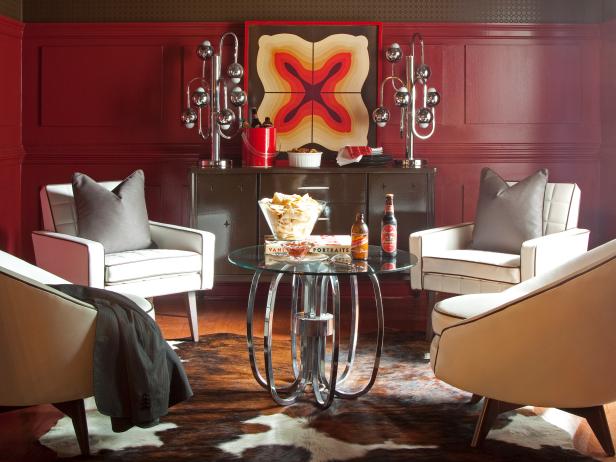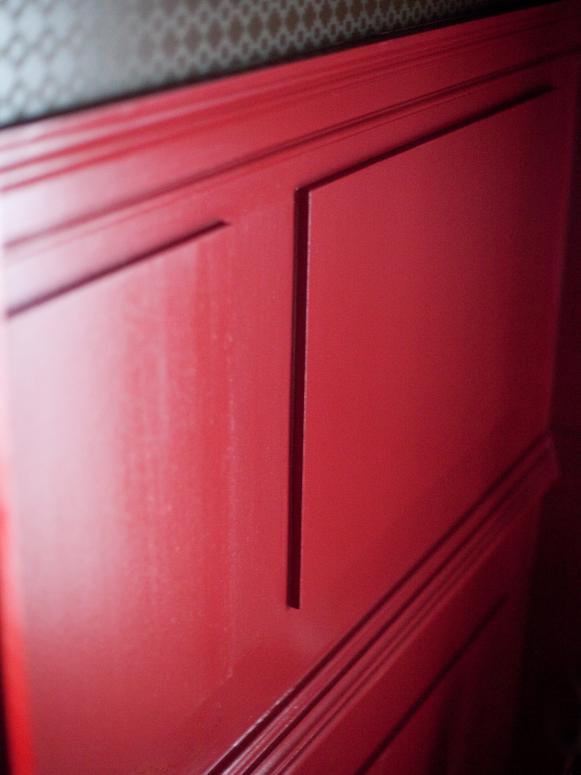'70s Throwback: Bonus Room Redesign Goes Retro

In 2007 Web designer Matthew Krivanek purchased his 2,300-square-foot Decatur, Ga., home, complete with a bonus room he had no idea what to do with. Located just inside the first-floor entrance, the 9-by-7-foot space was nearly impossible to furnish. "There's not enough privacy for it to work as a home office, it's too small to be a functional dining room, and although I tried using it as a music room to play my piano, that ended up being a total waste of space since it nearly took up every square foot," says Matthew.
Retro Red and Brown Lounge
See All PhotosAfter living in the house for a year, Matthew came up with the perfect use for the space. "My business partners and I were always meeting to go over design in my living room right in front of my TV, which was very distracting," he says. "So I decided to rework the bonus room as a brainstorming lounge, which could also be used after hours for cocktails or games." Matthew made plans to give the space a sexy, masculine redesign, and stuck with a budget of $4,000 and a timeline of eight weeks.

Brian Patrick Flynn
First up on Matthew's to-do list was adding architectural interest. To do this his contractor installed four-and-a-half-foot-tall panels made of MDF painted in a glossy red. "The paneling set me back about $500 for the materials and installation, but I did the actual painting myself," says Matthew.
Determined to give the affordable material a high-end, custom look, he opted for high-gloss oil-based paint. Although Matthew loves the final look, the experience of working with oil-based paint was something he's not looking forward to re-living anytime soon, explaining, "Oil paint is really tricky to work with. You have to be really careful with brush strokes or roller marks and it takes a full day before a single coat dries." Altogether the painting of the paneling took Matthew two full weekends.
Storage was another important element of Matthew's cyber lounge. The only supplies he needs for work are laptops, but storage was essential for laptop accessories such as media cards, extra hard drives, headphones and power cords. Matthew picked up a vintage credenza from a friend's garage sale, then paid his contractor to spray it in a brown lacquer that would contrast against the red lacquered wall panels.

Brian Patrick Flynn
For an element of surprise, he had the interior of the credenza lacquered in the same red used on the walls. In addition to electronics for work, Matthew uses the credenza to store board games he and friends put to good use on nights and weekends. "My lounge is as equally used for work as it is for play," he says. "So my storage solution needed to accommodate both."
To furnish the small space properly, Matthew stuck with club chairs rather than a sofa or banquette-style seating. "The only way to use the space right was to float club chairs in the center," he says. "It allows my colleagues and I to gather close enough to one another to see what we're working on, and it's also great for conversation."
With the painting complete, Matthew focused on incorporating a geometric, 1970s pattern on the walls. After looking through several wallpaper books, he decided on a Schumacher print called Shake It Up in a dark brown tone. Uncertain of his own patience to tackle the wallpaper himself, Matthew hired a professional paperhanger to install it for him. "Matching the pattern repeat is pretty difficult. If you cut the strip of paper too short or too long, it creates waste," Matthew says. "My paperhanger got it done in about four hours and charged $25 per roll to hang it."
Since Matthew needed a total of six rolls, his wallpaper-hanging labor costs only came to $150, but there were more costs involved he hadn't accounted for. "I didn't know that walls have to be primed in order for wallpaper to adhere until my paperhanger told me when she showed up. Priming was an extra $100," says Matthew. "If I'd have known about it, I would have just done it myself and saved money."
On a day-to-day basis, Matthew and his colleagues would be using the space for pitch and brainstorm meetings for designs and layouts. This would require proper lighting, especially since the room's new color scheme gives it an overall dark appearance. To illuminate the space with enough light to see properly, he had a transitional-style chandelier installed and put on a dimmer. In addition to adding light, the piece also brought in some interesting textures and finishes. The base is made of chrome, has shades upholstered in velvet, and sports decorative touches of clear Lucite.

Brian Patrick Flynn
Eager to keep his budget in check, Matthew went to a local estate sale where he found two pairs of different club chairs for $50 each. Matthew chose white vinyl for the upholstery and dark brown vinyl for welting and button detail. Altogether the four chairs set Matthew back $1,200, including upholstery and vinyl.
Now that his small space has a purpose, it's getting its fair share of use not only Monday through Friday, but also on Saturday nights. "Everyone wants to hang out in the lounge," Matthew says. "They love it as much as I do. In fact, my photographer friends keep using it as a set." Not only is he getting a ton of mileage out of his newly repurposed space, he's playing his piano now more than ever, noting, "Since my piano is not shoved into a corner, I can actually use it." With Matthew's lounge packed just as often with colleagues as it is with guests, it's hard to differentiate weekends from weekdays.








































